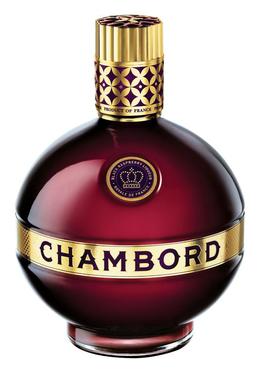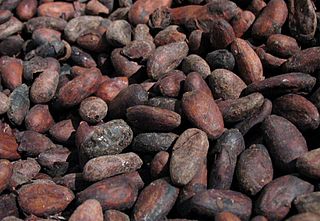
Violet is the color of light at the short wavelength end of the visible spectrum. It is one of the seven colors that Isaac Newton labeled when dividing the spectrum of visible light in 1672. Violet light has a wavelength between approximately 380 and 435 nanometers. The color's name is derived from the Viola genus of flowers.

Cognac is a variety of brandy named after the commune of Cognac, France. It is produced in the surrounding wine-growing region in the departments of Charente and Charente-Maritime.

Crème de cassis is a sweet, dark red liqueur made from blackcurrants.

Crème caramel, flan, caramel pudding, condensed milk pudding or caramel custard is a custard dessert with a layer of clear caramel sauce.

Grand Marnier is a French brand of liqueurs. The brand's best-known product is Grand Marnier Cordon Rouge, an orange-flavored liqueur created in 1880 by Alexandre Marnier-Lapostolle. It is made from a blend of Cognac brandy, distilled essence of bitter orange, and sugar, containing 40% alcohol. It is commonly consumed "neat" as a cordial or a digestif, and can be used in mixed drinks and desserts. Popular examples of the latter include crêpes Suzette and crêpes au Grand Marnier.

Crème de Noyaux is an almond-flavored crème liqueur, although it is actually made from apricot kernels or the kernels of peach or cherry pits, which provide an almond-like flavor. Both Bols and Hiram Walker produce artificially colored red versions of the liqueur while Noyau de Poissy from France is available in both clear (blanc) and barrel-aged amber (ambre) versions.

Panna cotta is an Italian dessert of sweetened cream thickened with gelatin and molded. The cream may be aromatized with coffee, vanilla, or other flavorings.

Chambord is a 16.5% abv raspberry liqueur modelled after a liqueur produced in the Loire Valley of France during the late 17th century. The Chambord product brand has been owned and produced by the Brown-Forman Corporation since 2006.
Crème de violette and liqueur de violette are generic terms for a liqueur with natural and/or artificial violet flower flavoring and coloring with either a brandy base, a neutral spirit base, or a combination of the two. The taste profile and aroma are distinctly floral and sweet, and reminiscent of the violet candies popular in the early to mid 20th century. Its known production dates back to the early 19th century when it was served with dry vermouth or alone as a cordial.
Domaine de Canton is a ginger-flavored liqueur made in France since 2007. Its earlier formulation was made in China from 1992–1997.

Chocolate liqueur is a chocolate flavored liqueur made from a base liquor of whisky or vodka. Unlike chocolate liquor, chocolate liqueur contains alcohol. Chocolate liqueur is often used as an ingredient in mixology, baking, and cooking.

The cuisine of Philadelphia was shaped largely by the city's mixture of ethnicities, available foodstuffs and history. Certain foods have become associated with the city.

Whipped cream, also known as Chantilly cream or crème Chantilly, is high-fat dairy cream that has been aerated by whisking until it becomes light, fluffy, and capable of holding its shape. This process incorporates air into the cream, creating a semi-solid colloid. It is commonly sweetened with white sugar and sometimes flavored with vanilla. Whipped cream is often served on desserts and hot beverages, and used as an ingredient in desserts.
Parfait d'amour, or parfait amour, is a liqueur. It is often used in cocktails primarily for its purple colour, and is generally created from a curaçao liqueur base.
Lucas Bols N.V. is a Dutch public company in the business of production, distribution, sales and marketing of alcoholic beverages. It claims to be the oldest distillery brand in the world. Its brand portfolio consists of Bols, Galliano, Vaccari, Pisang Ambon, Gold Strike and a large group of Dutch genevers and liqueurs. It produces about 3 million cases a year, with yearly revenues exceeding 95 million euros.

The aviation is a cocktail made with gin, maraschino liqueur, crème de violette and lemon juice. Some recipes omit the crème de violette. It is served straight up, in a cocktail glass.
St-Germain is an elderflower liqueur. It is made using the petals of Sambucus nigra from the Savoie region in France, and each bottle is numbered with the year the petals were collected. Petals are collected annually in the spring over a period of three to four weeks, and are often transported by bicycle to collection points to avoid damaging the petals and thus affecting the flavour.
Sweet Revenge is a 77-proof liqueur with natural flavorings that include wild strawberry and citrus, according to the manufacturer's website, literature and public trademark documents. It is essentially a blended sour mash whiskey flavored with fruit syrup(s). The liqueur has a vivid semi-translucent pink color and a sweet, assertive strawberry-dominant flavor. Sweet Revenge is marketed in a 750 mL size bottle with a silhouette similar to that of vintage American whiskey brands. It is promoted as a shot beverage with relatively high alcohol content – the liqueur is typically served undiluted in a shot glass or on the rocks.
Forbidden Fruit was a 32-40% ABV grapefruit liqueur first created in the late 1800s and manufactured by Charles Jacquin et Cie. It was significant in pre-Prohibition cocktail recipes and continued being used frequently after the repeal of Prohibition in the United States. It ceased production in the late 1970s as its classic spherical bottle design was used for the then new Chambord.












